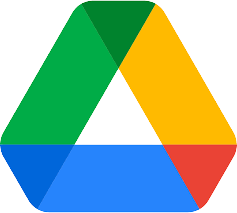Google Drive to iCloud: 4 Easy Ways to Transfer (2025)
Switching from Google Drive to iCloud Drive doesn’t have to be complicated. This guide explores four practical methods—from quick browser uploads to automated cloud-to-cloud transfers—so you can move your data securely without draining local bandwidth.
Introduction
As more users shift from Google Drive to Apple’s iCloud Drive, the question of how to move files efficiently has become increasingly common. Whether you’re consolidating storage, moving work documents into the Apple ecosystem, or simply syncing files across devices, having the right transfer method is essential. In this guide, we’ll look at four proven approaches—from straightforward browser-based uploads and iPhone/iPad options to advanced tools like [Rclone](https://rclone.org/drive/) and automated solutions such as [CloudsLinker](https://www.cloudslinker.com). No matter your technical skill level, you’ll find a method that fits your needs.
Google Drive is Google’s flagship cloud storage service, widely used for personal files, education, and business collaboration. Every Google account comes with 15 GB free storage, shared across Gmail, Google Photos, and Drive. Extra space can be purchased via Google One plans.
- Cross-device access: Open your files from Android, iOS, macOS, Windows, or any browser.
- Collaboration in real time: Edit documents, spreadsheets, and presentations with others simultaneously.
- Integration: Works seamlessly with Gmail, Google Docs, Meet, and other Google services.
- Backup & restore: Protects photos, videos, and device data with auto-backup features.
- Flexible storage: Individual files can be up to 5 TB in size (with paid plans).
iCloud Drive is Apple’s native cloud storage, built to sync files across iPhone, iPad, Mac, and even Windows. Each Apple ID includes 5 GB of free storage, with upgrades available up to 12 TB through iCloud+.
- Apple ecosystem integration: Your Desktop and Documents folder on Mac are automatically available across devices.
- File size support: Handles uploads up to 50 GB each, perfect for high-resolution videos or design files.
- Multi-platform: Accessible via Finder (Mac), Files app (iOS/iPadOS), File Explorer (Windows), or the iCloud website.
- Collaboration tools: Share files/folders with permissions, co-edit in Pages, Numbers, and Keynote.
- Privacy & security: End-to-end encryption and Apple’s Advanced Data Protection keep your data safe.
Many people start with Google Drive because of its generous free storage and strong integration with Gmail and Docs. But if you’ve recently switched to Apple devices—or you’d rather keep everything inside one ecosystem—moving your data to iCloud Drive can simplify daily use and reduce app-switching.
- Tight Apple Integration: iCloud Drive works natively with Finder on macOS, the Files app on iOS/iPadOS, and even integrates into productivity tools like Pages and Numbers.
- Seamless Mobile Experience: Your files sync automatically across iPhone, iPad, and Mac—no third-party apps required.
- Privacy & Security: With end-to-end encryption and optional Advanced Data Protection, your documents and photos stay secure within Apple’s cloud.
- Large File Support: iCloud Drive accepts uploads up to 50 GB per file—handy for videos, graphics projects, and backups.
- Collaboration: Share folders or individual files with precise permission controls and co-edit in real time with Apple apps.
- Scalable Plans: Start with 5 GB free and expand up to 12 TB with iCloud+, suitable for families and professionals alike.
If you’re moving away from Google’s ecosystem and prefer deeper Apple integration, iCloud Drive is a logical destination. It reduces friction across devices and provides a smoother workflow for anyone relying heavily on iPhone, iPad, and Mac.
Before deciding to move from Google Drive into iCloud Drive, it helps to understand the differences. While both platforms cover the basics of storage and syncing, they serve different priorities in terms of integration, collaboration, and pricing.
| Feature | Google Drive | iCloud Drive |
|---|---|---|
| Free Storage | 15 GB (shared across Gmail, Photos, Drive) | 5 GB |
| Platform Integration | Strong with Google services (Docs, Gmail, Meet, Android) | Best within Apple ecosystem (iOS, macOS, iPadOS) |
| Collaboration | Real-time editing in Google Workspace | Co-edit in Pages, Numbers, and Keynote with iCloud sharing |
| Third-Party Integration | Extensive (Slack, Zoom, Trello, MS Office) | Primarily Apple apps, limited external support |
| File Size Limit | Up to 5 TB per file (with paid plans) | Up to 50 GB per file |
| Security | Encryption in transit & at rest, 2FA via Google account | End-to-end encryption with optional Advanced Data Protection |
Google Drive is ideal for collaboration-heavy environments and cross-platform work, while iCloud Drive fits best for users deeply invested in Apple devices. If you rely on iPhone and Mac every day, migrating makes sense for convenience and tighter integration.
Before moving your files, review your Google Drive storage usage. Check how much data you currently have and whether it fits within the iCloud+ plan you intend to use. Since iCloud only gives 5 GB free, most users will need to upgrade if they are migrating large photo libraries or work archives.
Make sure you’re signed in with your Apple ID and have iCloud Drive enabled on your devices. You can manage this in Settings → [Your Name] → iCloud → iCloud Drive on iOS or in System Settings → Apple ID → iCloud on macOS. Having everything active before starting will make the transfer much smoother.
A little preparation helps: clean up old files in Google Drive, organize important folders, and decide whether you’ll transfer manually, use Rclone, or let CloudsLinker handle the migration automatically. This way, your folder structure and important documents won’t get lost in the shuffle.
Method 1: Transfer via Web Browsers
Step 1: Download Files from Google Drive
Open the official Google Drive web interface and log in with your Google account.
Browse to the files or folders you’d like to move into iCloud. To select multiple items, hold down
the Ctrl key on Windows or Command on macOS.
Click the Download option from the top toolbar (or right-click on your selection). Google Drive will package folders as ZIP files. Once the download finishes, unzip them locally so you can re-upload the individual files into iCloud Drive.
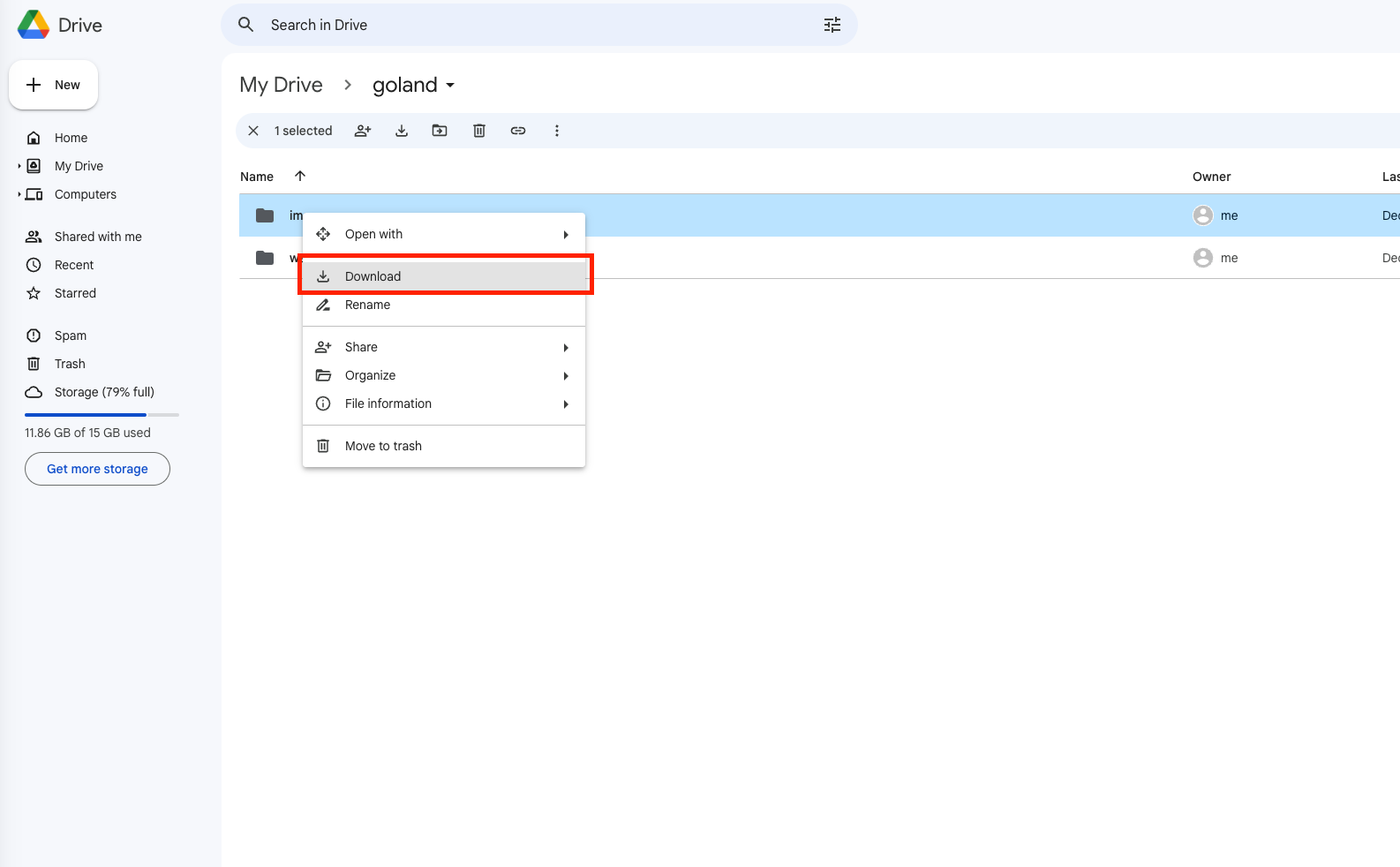
Step 2: Upload Files to iCloud Drive
Go to iCloud.com and sign in with your Apple ID. If you haven’t enabled iCloud Drive before, make sure it’s turned on in your Apple ID settings. Once inside the iCloud Drive interface, click the "Upload" button (cloud with an arrow), or simply drag and drop your files into the browser window.
You can organize files into folders as you go, or recreate the same folder structure you had on Google Drive for consistency. This helps keep documents, media, and work files easy to locate across your Apple devices.
Using a web browser is the simplest way to handle smaller migrations or one-time transfers. However, if you have a large library or need automation, relying on tools like Rclone or a dedicated cloud-to-cloud transfer service will save time and reduce the risk of interruptions.
Method 2: Transfer Using Your iPhone or iPad
Step 1: Open the Google Drive App and Download Files
On your iPhone or iPad, launch the Google Drive app and sign in with your Google account. Locate the files or folders you want to migrate. Tap the three-dot menu next to a file, then choose “Open in” or “Send a copy”. From here, you can save a local copy of the file or pass it directly into Apple’s Files app.
Step 2: Save into iCloud Drive via Files App
When the iOS share sheet opens, pick “Save to Files”. From there, choose iCloud Drive as the destination. You can either drop the file directly into your root folder or select a subfolder for better organization. Once confirmed, the file will upload to your iCloud Drive and sync automatically across your Apple devices.
This method is ideal for quick transfers of individual documents, photos, or PDFs while on the go. It leverages Apple’s native Files app, so you don’t need a computer. Keep in mind, though, that moving larger folders or hundreds of files can be time-consuming on mobile. For bulk migrations, using a desktop tool or an automated service like CloudsLinker will save you time and hassle.
Method 3: Command-Line Transfer with Rclone
Step 1: Install Rclone and Configure Your Remotes
For users comfortable with the command line, Rclone offers a highly flexible way to move data between clouds. It supports dozens of providers—including Google Drive and iCloud Drive.
First, download Rclone from the
official release
page.
Once installed, open your terminal (or Command Prompt on Windows) and run:
rclone config. This will launch the interactive setup wizard.
- Google Drive Remote: Select
driveas your backend. Rclone will prompt you to authenticate with your Google account through a browser window. Once authorized, you’ll have a remote (e.g.,gdrive:) that points to your files in the cloud. - iCloud Remote: Choose
icloudto configure direct access to iCloud Drive. Rclone will guide you through token generation and authentication. More details are available in the iCloud backend docs. - macOS Local Option: If you’re on a Mac, you can also point Rclone at your local
iCloud
Drive folder:
~/Library/Mobile Documents/com~apple~CloudDocs. This works if iCloud is already synced to your computer.
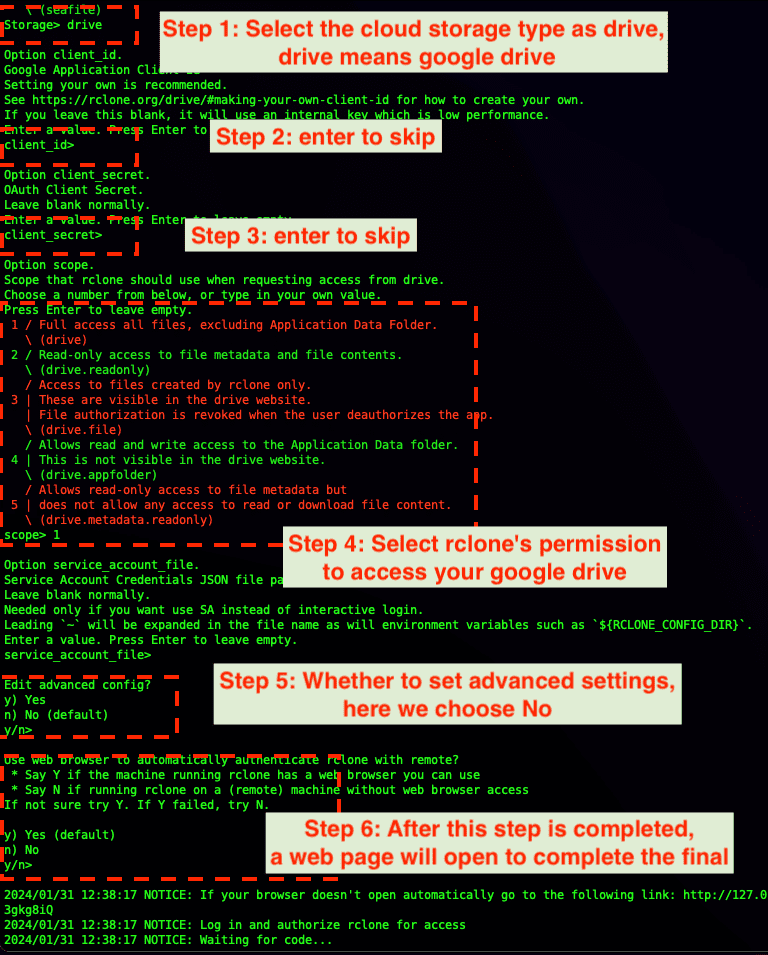
Step 2: Run the Transfer Command
Once both remotes are configured, you can start copying files. For example:
rclone copy gdrive:/MyDocs icloud:/MyBackup --progressrclone sync gdrive:/Photos icloud:/Photos --progress --exclude "*.tmp"
The first command copies everything from the MyDocs folder in Google Drive into a folder
named
MyBackup in iCloud Drive. The second example performs a sync of Google Drive photos,
excluding
temporary files. Add --dry-run if you want to preview the operation before running it for
real.

Rclone is best suited for power users who want speed, fine-grained control, or automation. You can limit bandwidth, apply filters, or schedule recurring syncs using cron (Linux/macOS) or Task Scheduler (Windows). The only caveat: initial setup requires some patience, especially when generating tokens for iCloud.
Method 4: Cloud-to-Cloud Transfer with CloudsLinker
Overview: Google Drive to iCloud Drive Without Downloads
CloudsLinker
lets you move files directly between cloud services—no manual downloads, re-uploads, or local
storage space required.
It currently supports 40+ major cloud providers, including
Google Drive and iCloud Drive, with all transfers processed
entirely in the cloud.
Step 1: Log in to CloudsLinker
Go to app.cloudslinker.com and sign into your account. Registration is free if you’re new. From the dashboard, click "Add Cloud". Start by adding your Google Drive account. You’ll be redirected to Google’s OAuth page—just like with Dropbox— where you securely grant access to CloudsLinker.
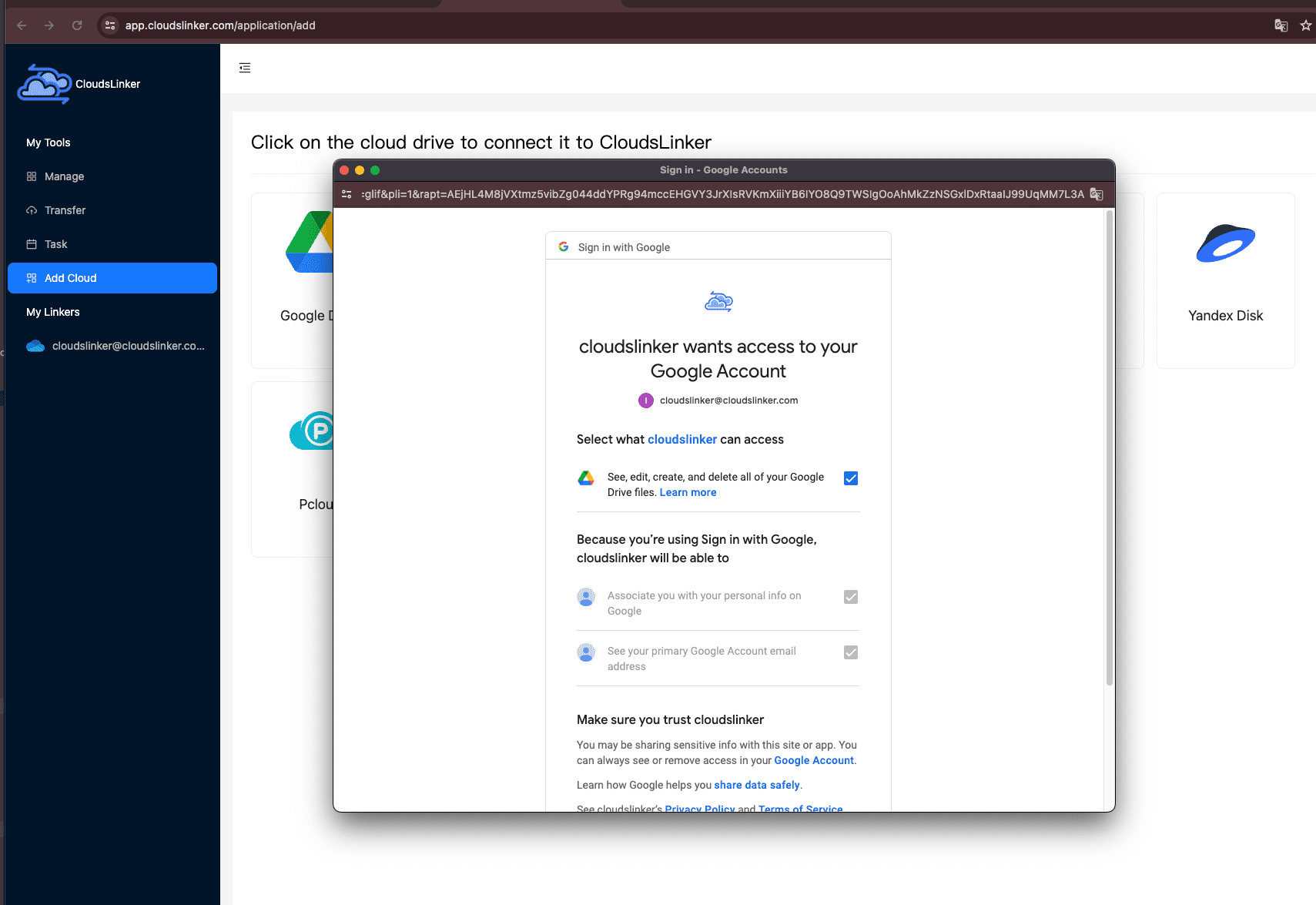
Google Drive connections are one-to-one, so once authorized, your account appears as a single drive in CloudsLinker, similar to how Dropbox works.
Step 2: Connect iCloud Drive
Next, choose iCloud Drive from the list. Enter your Apple ID credentials when prompted. If two-factor authentication is enabled, simply input the verification code sent to your Apple device. After this step, iCloud Drive will be fully linked to your CloudsLinker account.
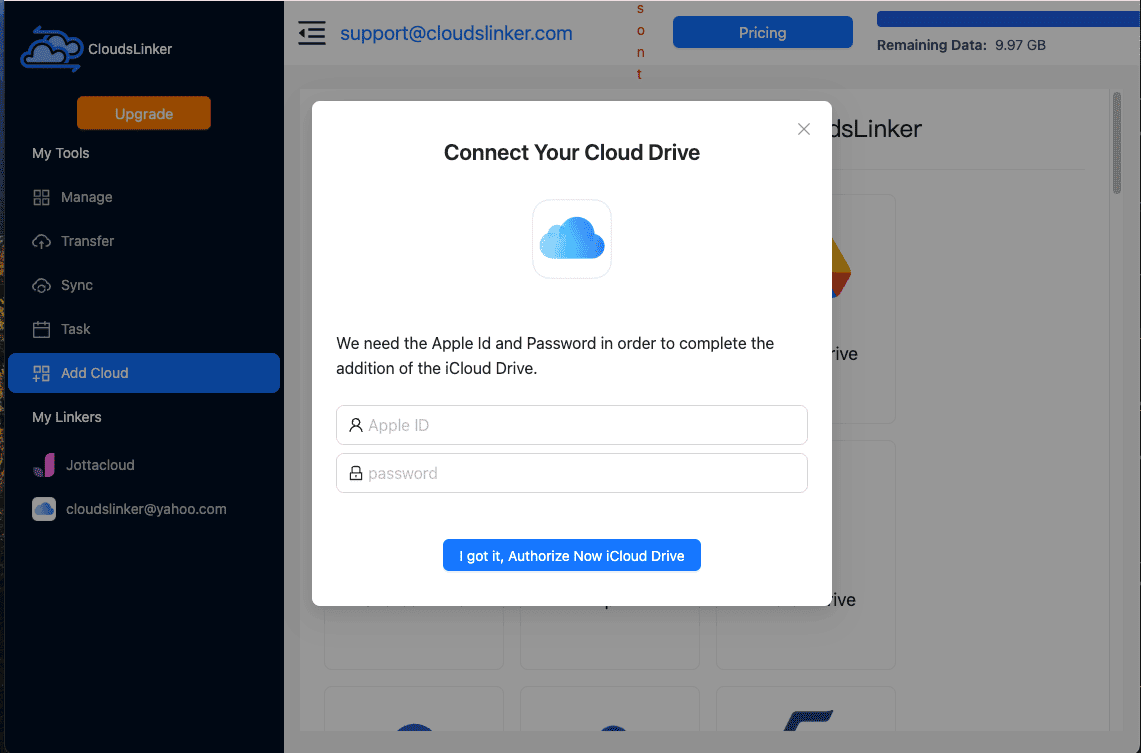
Step 3: Configure Your Transfer
Open the Transfer tab. On the left, pick Google Drive as the source and select the files or folders you want to move. On the right, choose iCloud Drive as the destination. You can browse both folder structures before confirming the transfer.

Want to refine the migration? Use advanced filters to skip certain file types (e.g.,
.tmp),
exclude oversized media, or only move files updated in the last month. These options make it easy to
tailor your transfer.
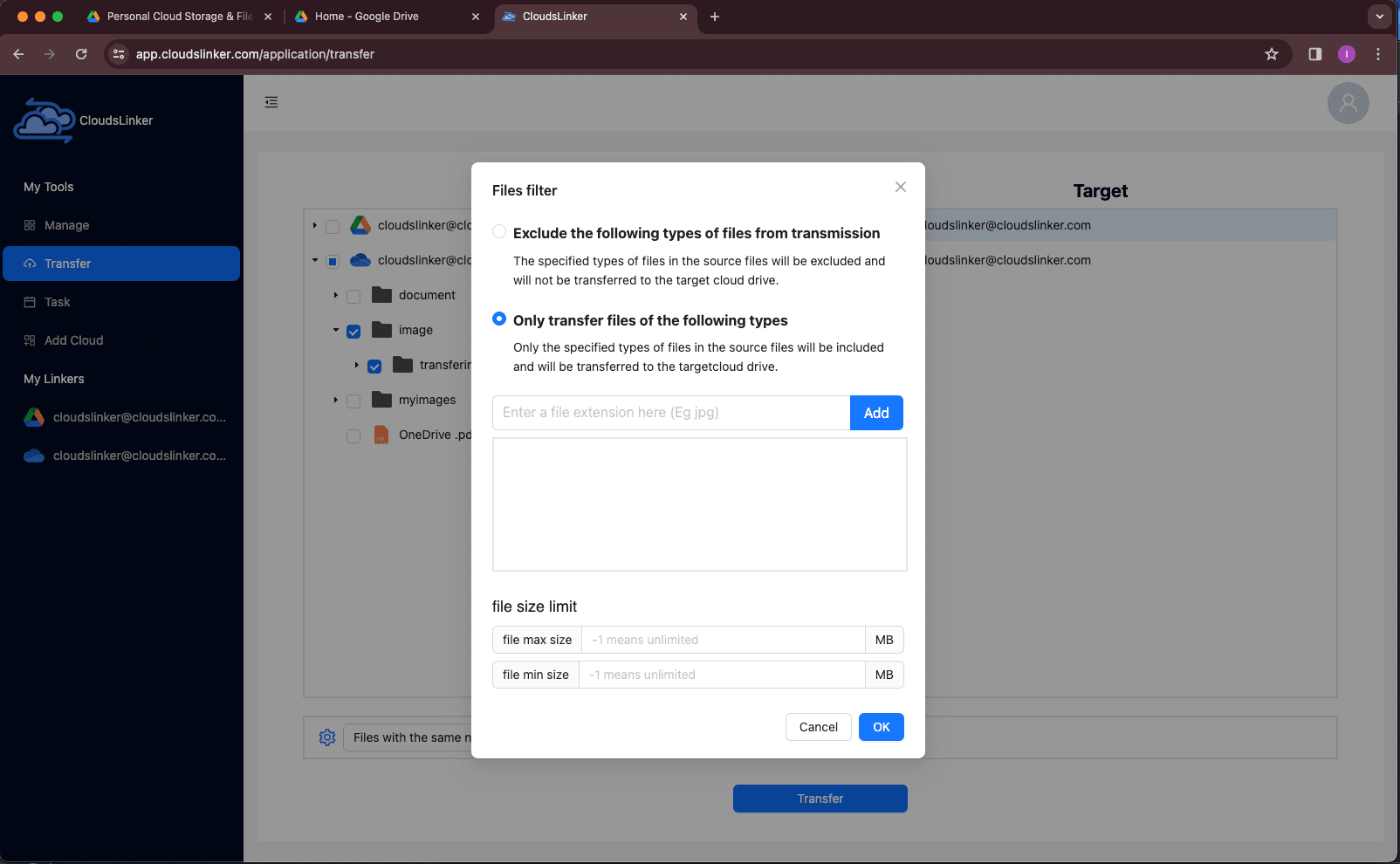
If you’d like Google Drive and iCloud Drive to stay in sync, go to the Schedule tab. You can automate recurring tasks—daily, weekly, or custom intervals. For more details, check our CloudsLinker scheduling guide.
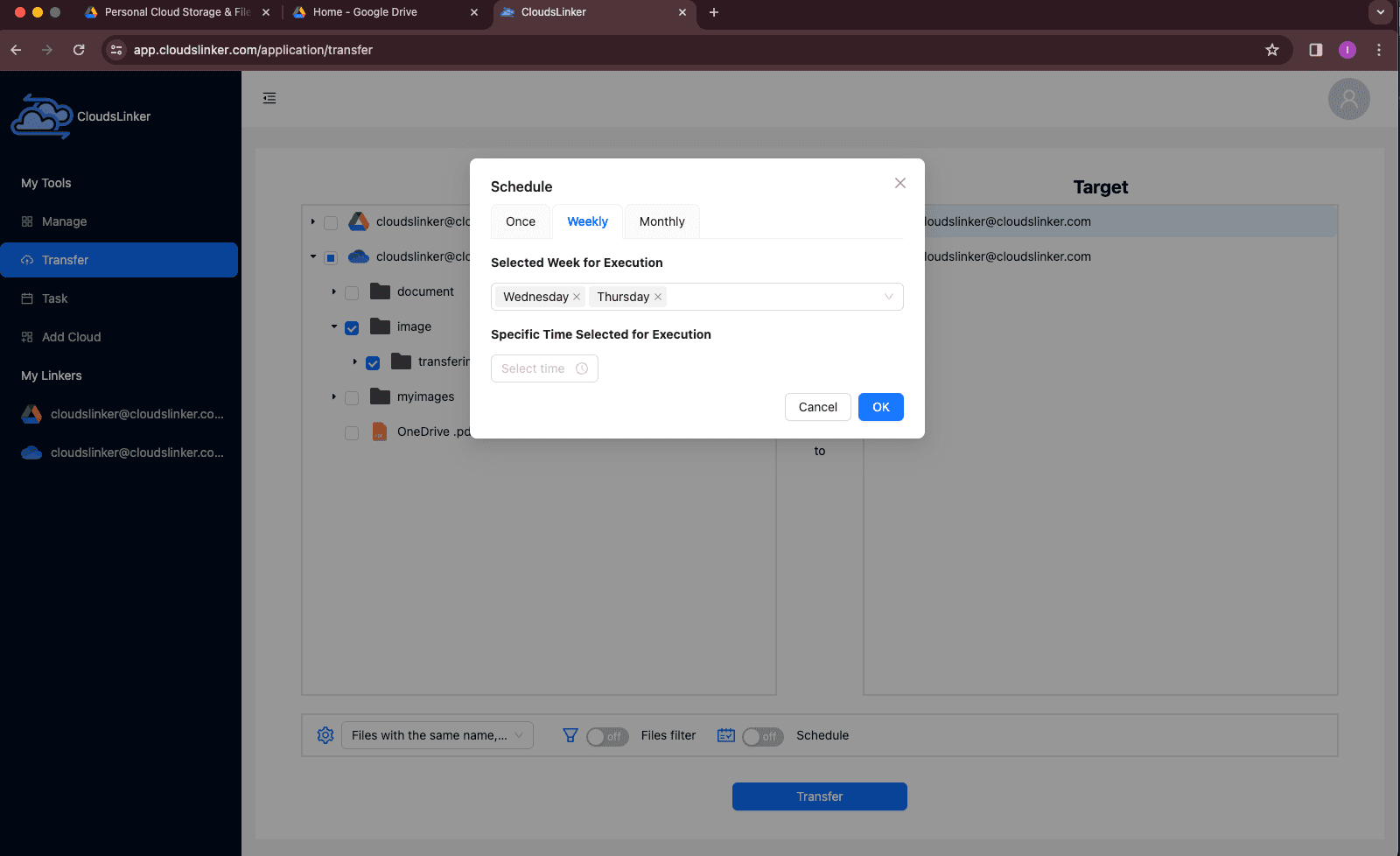
Step 4: Monitor and Finalize
Once started, your migration appears in the Task List. You’ll see live progress, speed, and estimated finish times. You can pause, resume, or re-run failed tasks. Any errors (like permission issues or unsupported file types) will be clearly flagged.
Step 5: Review Completion Report
After the job finishes, a report will summarize successes and failures. At this point, your chosen Google Drive files are safely in iCloud Drive.
For anyone wanting a fast, reliable, and completely cloud-based approach, CloudsLinker is one of the best tools available. It offers the convenience of “set it and forget it” transfers while still giving you advanced options for power users.
Need to Move Files Between Other Clouds?
Whether you’re using OneDrive, Box, MEGA, or WebDAV, CloudsLinker supports direct cloud-to-cloud transfers without eating up your bandwidth. Manage everything in your browser, and let the service do the heavy lifting.
Comparing the 4 Ways to Transfer from Google Drive to iCloud Drive
There isn’t a single “best” way to move files from Google Drive to iCloud Drive. The right approach depends on how many files you’re moving, how comfortable you are with technical tools, and whether convenience or control matters more. Here’s a side-by-side breakdown to help you decide:
| Method | Ease of Use | Speed | Best For | Uses Local Bandwidth | Skill Level |
|---|---|---|---|---|---|
| Web Browser (Manual) | ★★★★★ | ★★★☆☆ | Occasional, small transfers | Yes | Beginner |
| iPhone / iPad via Files App | ★★★★★ | ★★★☆☆ | Mobile users moving a few files | Yes | Beginner |
| Rclone (Command-Line) | ★★☆☆☆ | ★★★★★ | Power users, scripted or automated transfers | Yes / No (if both remotes are cloud-based) | Advanced |
| CloudsLinker (Cloud-Based) | ★★★★★ | ★★★★★ | Large folders, recurring syncs, minimal effort | No | Beginner |
If you only need to move a handful of documents or images, using a browser or the iPhone/iPad Files app is quick and straightforward. For automation, scheduling, or heavy data transfers, Rclone is a powerful option—but it requires some technical setup. For most people, though, especially those moving large libraries or wanting to avoid internet slowdowns, CloudsLinker is the most convenient choice. Since the transfer runs entirely in the cloud, it doesn’t depend on your device staying connected or consuming your home bandwidth.
Moving files from Google Drive to iCloud Drive is generally straightforward, but a little preparation helps prevent errors—especially if you’re migrating a large library or working with manual methods:
- Download Before Upload: If you’re using the browser method or the desktop sync app, make sure your Google Drive files are fully downloaded first. “Online-only” placeholders won’t move correctly until the content has synced to your machine.
- iCloud File Size Limits: iCloud Drive allows files up to 50 GB each. If you’re migrating large videos or archives, check file sizes in advance. For oversized data, consider splitting archives or using a cloud-to-cloud service like CloudsLinker.
- Avoid Bandwidth Bottlenecks: Manual transfers depend on your local internet speed. If your connection is slow or unstable, server-side tools such as CloudsLinker can handle the job without tying up your network.
- Check iCloud Storage: A free iCloud account starts with only 5 GB. If you’re bringing over a large Google Drive library, upgrade to an iCloud+ plan first to avoid running out of space mid-transfer.
- Use Secure Authentication: Always connect Google Drive and iCloud using OAuth login flows rather than entering passwords directly. Tools like CloudsLinker use secure tokens and AES-256 encryption, ensuring that your credentials remain private.
- Handling Very Large Migrations: If you’re transferring hundreds of gigabytes, look for features like scheduled sync, error recovery, and background processing. CloudsLinker can resume tasks automatically if your device goes offline or the connection drops.
A bit of planning goes a long way. Whether you’re shifting a handful of files or an entire archive, understanding the limits and preparing your accounts ensures a smoother move from Google Drive into iCloud Drive.
Frequently Asked Questions
Watch Our Step-by-Step Video Tutorial
Learn how to transfer files from iCloud Drive to Dropbox with our clear, visual walkthrough. This tutorial is perfect for anyone—whether you're new to cloud storage or just looking for the easiest method. We’ll guide you through every step, from accessing your files in iCloud to syncing them with Dropbox using various tools including Cloudslinker. Get expert tips, avoid common mistakes, and simplify your cloud migration process. Watch now and move your files with confidence!
Conclusion
We’ve explored four effective ways to transfer files from Google Drive to iCloud Drive, each suited to different scenarios. For quick, smaller migrations, browser uploads or iOS transfers are convenient. For those handling larger datasets or looking for scriptable control, Rclone is a powerful option. And if you want a fully automated solution that runs entirely in the cloud without using your internet, CloudsLinker offers unmatched convenience. Choosing the right method ensures that your files stay organized, accessible, and ready for use across your Apple devices.
Online Storage Services Supported by CloudsLinker
Transfer data between over 45 cloud services with CloudsLinker
Didn' t find your cloud service? Be free to contact: [email protected]
Further Reading
Effortless FTP connect to google drive: Transfer Files in 3 Easy Ways
Learn More >
Google Photos to OneDrive: 3 Innovative Transfer Strategies
Learn More >
Google Photos to Proton Drive: 3 Effective Transfer Techniques
Learn More >

